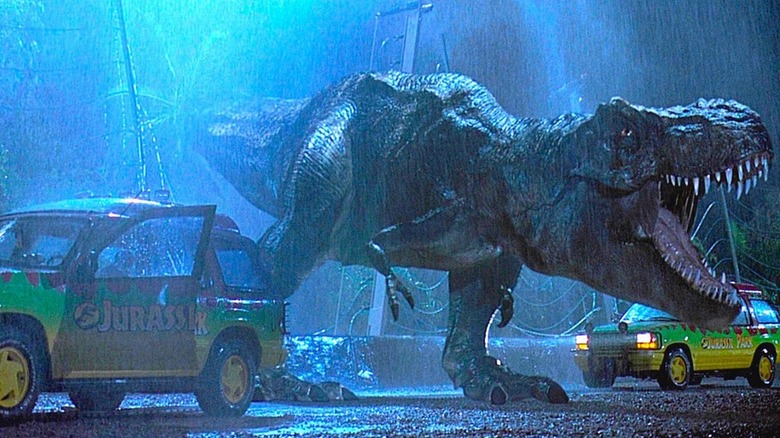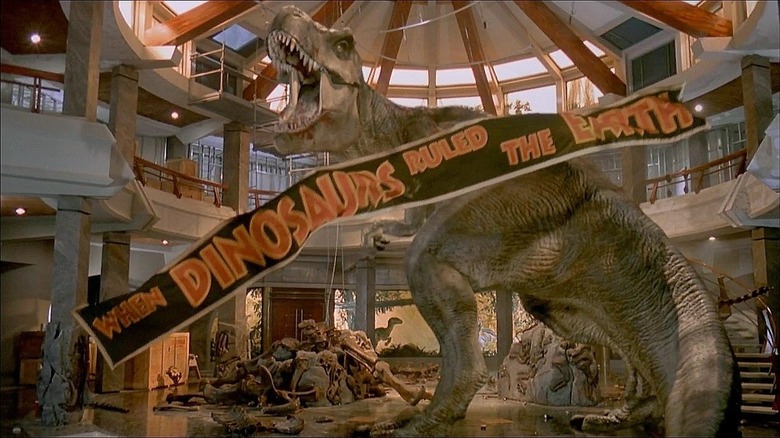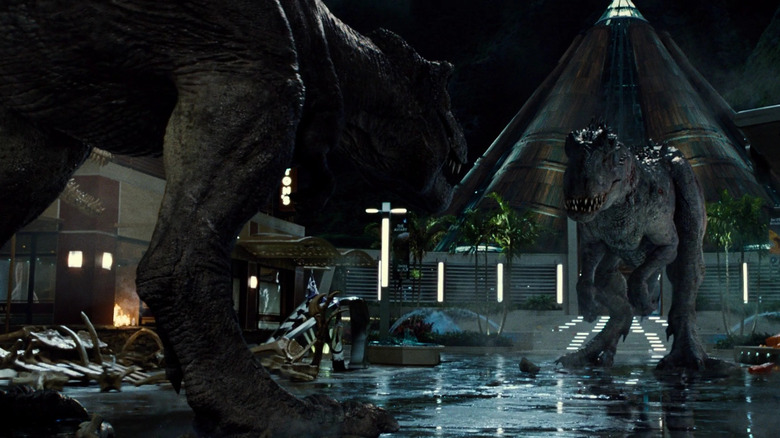Creating Jurassic Park's Climactic Scene Was A Last-Minute Scramble
It's become a bit of a cliche to describe a film as a roller coaster ride, but if any movie earns such a description, it's "Jurassic Park." Director Steven Spielberg made the 1993 blockbuster with all the aplomb befitting his prior hits like the "Indiana Jones" trilogy, combining his penchant for meticulously choreographed and edited action sequences with a story involving a dinosaur amusement park run amok.
Yet the film's action set pieces weren't so meticulously choreographed that there was no room for innovation, as evident by the fact that Spielberg had a last-minute idea for the movie's climax that both the cast and crew agreed would be a fantastic addition. Despite everyone's excitement about the change, it meant that the production would need to scramble to accommodate it, a not-so-simple task considering the movie was already pushing boundaries with special and visual effects.
As originally scripted by screenwriters Michael Crichton (adapting his novel) and David Koepp, the finale of "Jurassic Park" would be much the same as it is in the finished film until Dr. Alan Grant (Sam Neill) and the other survivors emerge into the park's visitor center. As seen in this series of storyboards from the movie's DVD extras, the pursuing velociraptors would be defeated by both Grant manipulating the controls of a crane (causing a decorative Tyrannosaurus rex skeleton to crash into a raptor), and by John Hammond (Richard Attenborough) using a plain ol' shotgun. Yet all that changed when Spielberg was struck by inspiration on set.
The return of the film's biggest star: the T. rex
As the "Jurassic Park" finale was being shot, Steven Spielberg thought: What if, instead of just having a T. rex skeleton in the scene, the genuine article made a heroic reappearance? As assistant director John T. Kretchmer recalled during a 25th anniversary Q&A, "Steven came to us when we were in the middle of the sequence and said, 'I think we have to bring the T. rex back, the audience is going to want to see the T. rex.'" Kretchmer realized that Spielberg "was absolutely right, but we hadn't planned for any of that," especially the aspect of the rex killing the raptors while wrecking much of the visitor center around it.
With the new idea for the sequence not in any version of the script, Kretchmer and the rest of the "Jurassic Park" crew had to work together intelligently and rapidly to pull off the rex's return. As Kretchmer recalled: "Michael Lantieri, who was our special effects genius on the show, had to rig [the physical effects] in like 24 hours, it was an off-the-cuff thing." Spielberg gave cast members their new marks and direction, reacting now to the rex's majestic jaws as they capture an attacking raptor at the last second.
Following Spielberg's lead, visual effects supervisor Dennis Muren had to have his team do the bulk of the work putting the T. rex into the scene using computer graphics, with Kretchmer marveling that they pulled it off when they had "no storyboards" and "no plans for this whatsoever."
Fortunately, the scene came together, with everyone from Kretchmer, Lantieri, and Muren to cinematographer Dean Cundey and composer John Williams pulling off a stunning scene of final confrontation that never gives away its rushed, almost improvised origins. The final moment of the triumphant T. rex became so beloved that it even inspired its own merchandise, such as this poster art and this statue.
The forging of America's kaiju hero
Steven Spielberg's instincts about the audience's love for the T. rex were right on the money — perhaps even more than he realized. The rex's initial appearance in the film is the very definition of a grand entrance, one that establishes the creature as a character in her own right. Her saving the human characters at the end even helps make the argument that she's the true action hero of the film, as does the fact that she's prominently featured on the movie's poster and logo (sure, it's a skeleton version, but it's still recognizably a rex!).
The "Jurassic Park" series' love of the T. rex only grew with each successive entry in the franchise. In "The Lost World," two rex parents and their adorable baby play a major role in the story, while the rex's death in "Jurassic Park III" and her rescue from mistreatment at the hands of unscrupulous scientists in "Jurassic World: Fallen Kingdom" rely on the audience sympathizing with the rex far more than fearing her.
The finale of 2015's "Jurassic World" follows through on the promise of Spielberg's improvised ending, turning the rex into a fully fledged monster hero as she knocks the tar out of the big bad Indominus rex (with a little help from Blue the raptor and a mosasaurus). All the T. rex's appearances in the "Jurassic" saga help make her into America's answer to Japan's kaiju creatures, the dinosaur neither fully anthropomorphized nor unsympathetic.
Thanks to Spielberg's uncanny instinct for character, pacing, and story, the "Jurassic Park" cast and crew's professionalism and all their on-the-fly hard work, the end result feels as accomplished as if the scene had been, as the film's tagline famously claimed, "65 million years in the making" — even if it was closer to 65 minutes.


